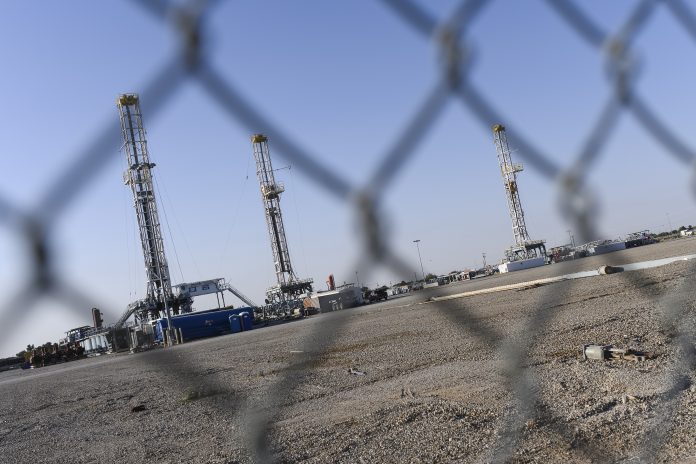Oil and gas prices are very high, driving up the cost of gasoline and contributing to burgeoning inflation, but they’re also supporting increased hiring in the oilfield and spurring drillers to drill, pipeliners to pump and refineries to keep churning out their panorama of products.
With oil at $105.75 per barrel and natural gas at $7.244 per thousand cubic feet on Monday, Waco economist Ray Perryman, State Rep Brooks Landgraf and spokesmen for the Texas Alliance of Energy Producers and the Austin-based Enverus Intelligence Research say prices will stay elevated for a long time, agreeing with an April 19 analysis by the World Bank in Washington, D.C., that Russia’s invasion of Ukraine “will alter energy trade flows, consumption and production for years.
“In the biggest energy shock since the 1970s, elevated commodity prices are worsening inflationary pressures,” the bank said.
Referring to European prices, which roughly parallel West Texas intermediate crude levels, it said, “The price of Brent crude will average $100 this year for the highest annual level since 2013 and it will moderate to $92 in 2023.
“Natural gas prices will be twice as high in 2022 as they were in 2021 and coal will be 80 percent higher, both all-time highs. High metal prices are driving up the cost of renewable energy, which depends on aluminum and battery-grade nickel.”
Perryman said geopolitics and other factors “can cause rapid swings in either direction on a temporary basis, but I believe long-term average prices will be higher.
“Even the U.S. Department of Energy forecasts recognize that the global demand for oil and gas will continue to increase under a wide variety of circumstances even as we move toward a more climate-sensitive energy framework,” said Perryman, who lives in Odessa. “At the same time, the recent actions taken by Russia are likely to materially affect the trade flows, transport costs and other factors.
“Producing oil with lower emissions, where the Permian Basin has a decided advantage, will be more expensive and added costs due to governmental policies seem probable. Logistics challenges posed by the Russian situation will likely persist and investors are seeking substantial returns to fund major drilling programs in a more uncertain environment. All these factors portend higher overall prices.
“This may be partially offset by further improvements in drilling and production technology, but there are more factors driving long-term prices up than down.”
Landgraf expressed some uncertainty about the World Bank’s predictions, but he was optimistic about the Permian Basin’s future. “My crystal ball isn’t always crystal clear when it comes to predicting commodity prices,” the Odessa Republican said.
“I can’t say whether or not the World Bank’s projections will come true, but I am certain that when it comes to global demand for energy, the world should look to the Basin for its supply of oil and natural gas,” Landgraf said. “We have an abundance of crude oil and other hydrocarbons without any of the geopolitical strings attached.
“Equally important, we have the people here in the West Texas oilpatch with the know-how, ingenuity and safety record to better meet the demand than any other region on earth. It is likely that instability in other parts of the world will lead to higher-than-expected energy prices. But I’m confident that the stability of Texas and the production in the Permian Basin could be the best available antidote.”
Texas Alliance of Energy Producers President Jason Modglin said from Austin that many countries’ withdrawal from doing business with Russia “is making it harder to move products around the world, but it will make the United States and particularly Texas far more important in meeting the needs of Europe and Asia.
“We hope the Biden administration will think longer term about the needs for oil and gas beyond a two-year or four-year cycle,” Modglin said. “That demand is not going away. We need production from nations with high environmental and labor standards and that is the U.S., not the rest of the world.”
He added that high oil and gas prices “are not a windfall for the energy industry because production costs are increasing just as rapidly for sand, steel, labor and trucking.
“We need continued investment to maintain production, but we have seen a lot of investors like the large banks start either to prohibit oil and gas investments or do away with them in favor of alternative technologies,” Modglin said.
Enverus Intelligence Research Senior Vice President Al Salazar said the possible elimination of Russia’s 17 percent of the world’s natural gas supply makes it “fairly easy to suggest that natural gas prices will stay high for years.
“Moreover, seemingly indefinite and mounting energy sanctions against Russia make such a statement more likely than not,” Salazar said. “However, commodity prices including natural gas are highly cyclical. History shows that if prices stay high for a long enough period, both supply and demand efficiencies come into play. The U.S. shale revolution is a prime example of this.”
He said key signposts for the future will be the discipline exercised or not exercised by American energy producers, the further globalization of liquefied natural gas and renewable generation growth with the balance that develops between energy security and the non-financial factors of environmental, social and governance considerations.
“Currently, our view is that U.S. natural gas prices appear increasingly influenced by international LNG markets,” Salazar said. “International prices for natural gas trade at multiples of what U.S. natural gas prices clear at should support the Henry Hub until infrastructure constraints become an issue.”
Based in Erath, La., the Henry Hub is a natural gas pipeline that is the official delivery point for futures contracts on the New York Mercantile Exchange. Owned by the Sabine Pipe Line Co., it connects to four intrastate and nine interstate pipelines.




